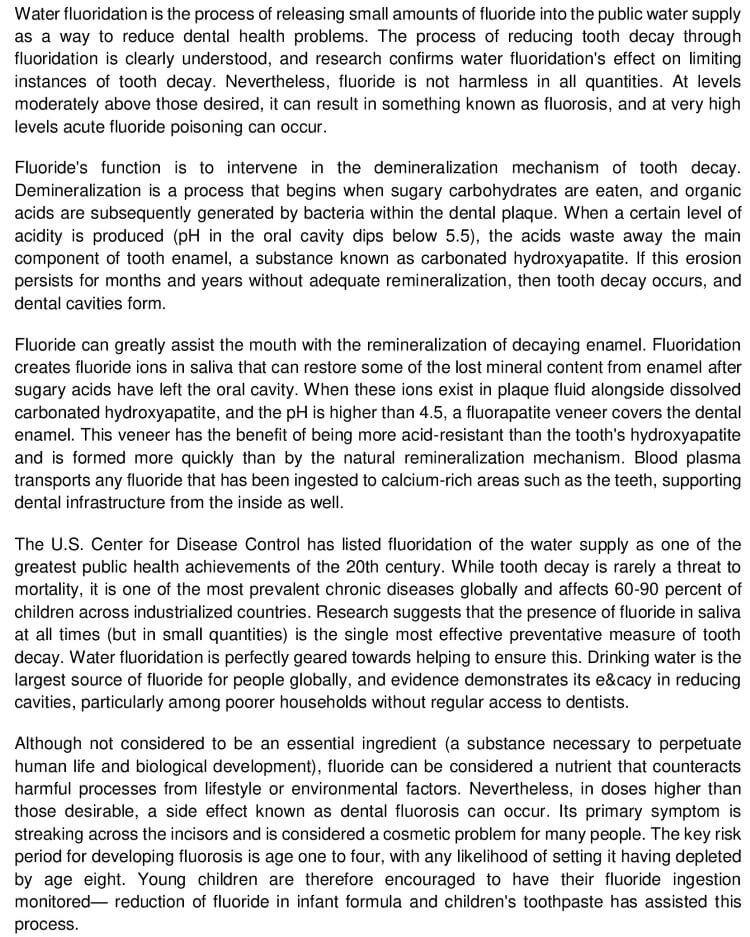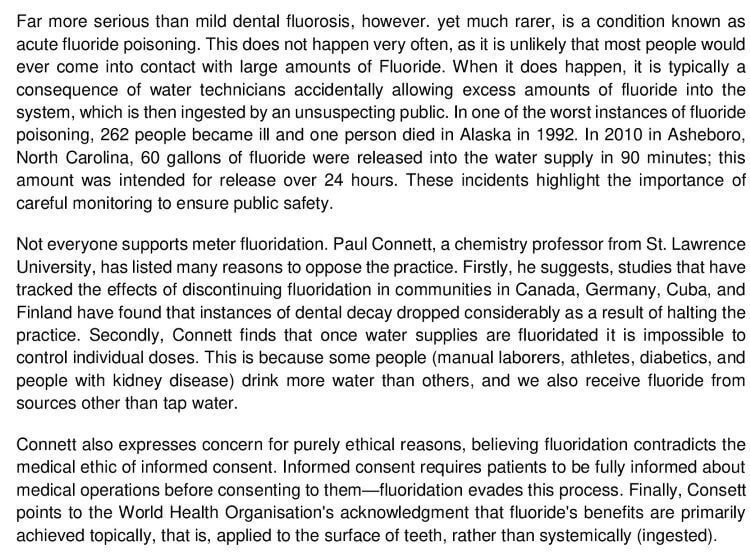Fluoridation of Public Water Supplies IELTS Reading Answer
7 min read
Updated On
-
Copy link
You will find IELTS Academic Reading passage, Fluoridation of Public Water Supplies Reading Answers, in this article. Practise this one and you will get an idea of how to deal with IELTS Reading.
Table of Contents

Limited-Time Offer : Access a FREE 10-Day IELTS Study Plan!
Various question types are asked in IELTS Academic Reading to test specific reading skills and some of them are given in Fluoridation of Public Water Supplies IELTS Reading Answers. These question types are:
- IELTS Reading Short Answer Questions (Q. 14-19)
- IELTS Reading Matching Features (Q. 20-24)
- IELTS Reading Multiple-Choice Questions (Q. 25-26)
Ideally, IELTS test-takers should take around 20 minutes to solve a passage like ‘Fluoridation of Public Water Supplies’ in IELTS Academic Reading. Therefore, to master this skill, they need to take IELTS reading practice tests regularly. Let’s see how easy this passage is for you and if you’re able to make it in 20 minutes.
Reading Passage
Fluoridation of Public Water Supplies


Questions of Fluoridation of Public Water Supplies
Questions 14-19
Answer the questions below using NO MORE THAN TWO WORDS from the passage for each answer.
Write your answers in boxes 14-19 on your answer sheet.
14 What does fluoridation affect to prevent tooth decay?
15 What do dental bacteria produce?
16 When mouth pH goes below 5.5, what is dissolved?
17 What does fluoridation form in the mouth to restore mineral density in teeth?
18 What is the coating that remineralization ferns on teeth?
19 Through what mechanism does swallow fluoride go-to teeth?
Questions 20-24
Complete each sentence with the correct ending, A-J, below.
Write the correct letter, A-I, in boxes 20-24 on your answer sheet.
20 Tooth decay
21 A constant, low level of fluoride in the mouth
22 Drinking water
23 Dental fluorosis
24 Acute fluoride poisoning
A Is the way most people around the world get fluoride
B Is a threat to public safety
C Can occur as a result of mishaps in adding fluoride to water
D Can be regarded as nutritious
E Is a widespread health issue in developed countries
F Is not as common in infants
G Is the best protection against tooth decay
H Is required to sustain our material survival and biological growth
I Is visible as faint lines across the teeth
j Is difficult to achieve amongst poorer people
Questions 25-26
Choose TWO letters A-E.
Write your answers in boxes 25-26 on your answer sheet.
Which TWO of the following statements form part of Connett’s opposition to fluoridation?
A Fluoridation is proven to be poisonous.
B Individuals react differently to fluoride.
C People may be fluoridated against their knowledge or will.
D Drinking water is not the most effective way to fluoridate teeth.
E When fluoridation stops, occurrences of tooth decay increase only slightly.
Answers of Fluoridation of Public Water Supplies Reading Answers With Location and Explanations
Go through the answers and detailed explanations of each question in the Fluoridation of Public Water Supplies passage and prepare to get a high IELTS band score.
14 Answer: demineralization mechanism
Question type: Short Answer Question
Answer location: Paragraph 2
Answer explanation: The initial lines of paragraph 2 state that Fluoride’s function is to intervene in the demineralization mechanism of tooth decay. Demineralization is a process that begins when sugary carbohydrates are eaten, and organic acids are subsequently generated by bacteria within the dental plaque. We can deduce from these lines that the function of fluoride is to pause the demineralization process of tooth decay. It is a process that starts when surgery carbs are eaten and organic acids are generated by bacteria within dental plaque. Thus, fluoridation affects demineralization mechanisms to prevent tooth decay. Hence, the answer is the demineralization mechanism.
15 Answer: organic acids
Question type: Short Answer Question
Answer location: Paragraph 2, line 2
Answer explanation: Paragraph 2 illustrates that the primary function of fluoride is to prevent the demineralization mechanism to prevent tooth decay. The 2nd line states that Demineralisation is a process that begins when sugary carbohydrates are eaten, and organic acids are subsequently generated by bacteria within the dental plaque. Dental bacteria produce organic acids. Thus, the answer is organic acids.
16 Answer: tooth enamel/ carbonated hydroxyapatite
Question type: Short Answer Question
Answer location: Paragraph 2, line 3
Answer explanation: The 3rd line of paragraph 2 states that when a certain level of acidity is produced (pH in the oral cavity dips below 5.5), the acids waste away the main component of tooth enamel, a substance known as carbonated hydroxyapatite. These lines suggest that when the acidity level is produced, the acid destroys the primary component of tooth enamel, a substance known as carbonated hydroxyapatite. Hence, it is evident that tooth enamel or carbonated hydroxyapatite is dissolved when mouth pH goes below 5.5. Thus, the answer is tooth enamel/ carbonated hydroxyapatite.
17 Answer: (fluoride) ione
Question type: Short Answer Question
Answer location: Paragraph 3
Answer explanation: The introductory line of paragraph 3 states that fluoride can greatly assist the mouth with the remineralization of decaying enamel. Fluoridation creates fluoride ions in saliva that can restore some of the lost mineral content from enamel after sugary acids have left the oral cavity. These lines indicate that fluoridation forms in the mouth to restore mineral density in teeth due to fluoride ions. Thus, the answer is fluoride ions.
18 Answer: fluorapatite
Question type: Short Answer Question
Answer location: Paragraph 3, line 3
Answer explanation: The 3rd line of paragraph 3 states that when these ions exist in plaque fluid alongside dissolved carbonated hydroxyapatite, and the pH is higher than 4.5, a fluorapatite veneer covers the dental enamel. These lines suggest that the fluoride ions exist in the plaque fluid with the dissolved carbonated hydroxyapatite (tooth enamel) and if the pH is higher than 4.5, a fluorapatite veneer covers the dental enamel. Thus, fluorapatite is the coating that remineralizations form on teeth. Hence, the answer is fluorapatite.
19 Answer: blood plasma
Question type: Short Answer Question
Answer location: Paragraph 3, last line
Answer explanation: The last line of paragraph 3 states that Blood plasma transports any fluoride that has been ingested to calcium-rich areas such as the teeth, supporting dental infrastructure from the inside as well. We can deduce from these lines that through the blood plasma mechanism, the swallowed fluoride goes to the teeth. Thus, the answer is blood plasma.
20 Answer: E
Question type: Matching Sentence Ending
Answer location: Paragraph 4, line 2
Answer explanation: The 2nd line of paragraph 4 states that while tooth decay is rarely a threat to mortality, it is one of the most prevalent chronic diseases globally and affects 60-90 percent of children across industrialized countries. These lines indicate that although tooth decay is rarely a threat to mortality, it’s one of the most common chronic diseases worldwide. Thus, tooth decay is a widespread health issue in developed countries. Hence, the answer is E.
21 Answer: G
Question type: Matching Sentence Ending
Answer location: Paragraph 4, line 4
Answer explanation: The 4th line of paragraph 4 states, Research suggests that the presence of fluoride in saliva at all times (but in small quantities) is the single most effective preventative measure of tooth decay. These lines indicate that according to the research, the presence of fluoride in the saliva is the single most effective preventive measure for tooth decay, which means a low level of fluoride in the mouth is the best protection against tooth decay. Thus, the answer is G.
22 Answer: A
Question type: Matching Sentence Ending
Answer location: Paragraph 4, last line
Answer explanation: The last line of paragraph 4 states that drinking water is the largest source of fluoride for people globally, and evidence demonstrates its efficacy in reducing cavities, particularly among poorer households without regular access to dentists. We can understand from these lines that drinking water is the largest way by which most people around the world get fluoride. Thus, the answer is A.
23 Answer: I
Question type: Matching Sentence Ending
Answer location: Paragraph 5
Answer explanation: Paragraph 5 states that nevertheless, in doses higher than those desirable, a side effect known as dental fluorosis can occur. Its primary symptom is streaking across the incisors and is considered a cosmetic problem for many people. These lines indicate that dental fluorosis is visible as faint lines across the teeth. Thus, the answer is I.
24 Answer: C
Question type: Matching Sentence Ending
Answer location: Paragraph 6
Answer explanation: Paragraph 6 states that it is far more serious than mild dental fluorosis, however. yet much rarer, is a condition known as acute fluoride poisoning. This does not happen very often, as it is unlikely that most people would ever come into contact with large amounts of Fluoride. It is evident from these lines that acute fluoride poisoning can occur as a result of mishaps in adding fluoride to water. Thus, the answer is C.
25 Answer: C
Question type: Multiple Choice Question
Answer location: Paragraph 7
Answer explanation: In the introductory lines of paragraph 7, it is mentioned that not everyone supports meter fluoridation, which means that people may be fluoridated against their will or knowledge. Thus, the answer is C.
26 Answer: D
Question type: Multiple Choice Question
Answer location: Paragraph 7, line 5
Answer explanation: The 5th line of paragraph 7 states that Connett finds that once water supplies are fluoridated it is impossible to control individual doses. This is because some people (manual laborers, athletes, diabetics, and people with kidney disease) drink more water than others, and we also receive fluoride from sources other than tap water. These lines indicate that drinking water is not the most effective way to fluoridate teeth. Thus, the answer is D.
Check More IELTS Reading Answers
Practice IELTS Reading based on question types

Start Preparing for IELTS: Get Your 10-Day Study Plan Today!
Recent Articles

Nehasri Ravishenbagam

Haniya Yashfeen

Haniya Yashfeen

Haniya Yashfeen




Post your Comments